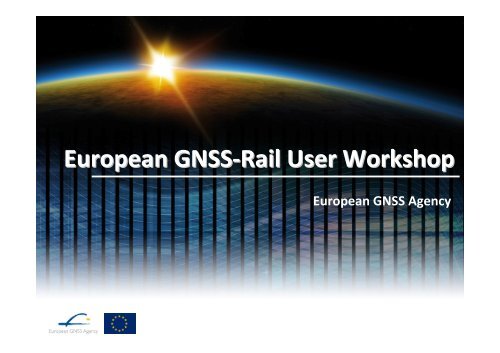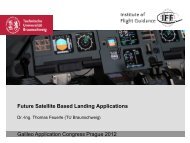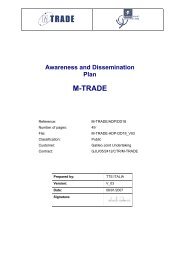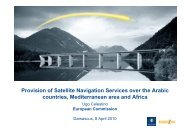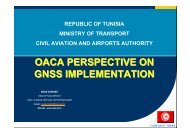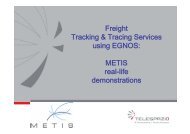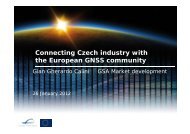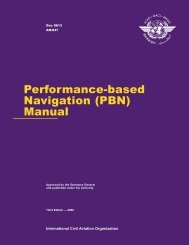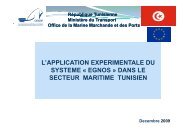European GNSS-Rail User Workshop_2012.pdf
European GNSS-Rail User Workshop_2012.pdf
European GNSS-Rail User Workshop_2012.pdf
Create successful ePaper yourself
Turn your PDF publications into a flip-book with our unique Google optimized e-Paper software.
<strong>European</strong> <strong>GNSS</strong>-<strong>Rail</strong> <strong>GNSS</strong> <strong>Rail</strong> <strong>User</strong> <strong>Workshop</strong><br />
<strong>European</strong> <strong>GNSS</strong> Agency
Introduction - GSA<br />
London Waterloo Station, Sunrise 2 December 2012
Overview of <strong>GNSS</strong><br />
3
Anticipated evolution of <strong>GNSS</strong> receivers
<strong>European</strong> <strong>GNSS</strong> services – partners to GPS<br />
Global Navigation Satellite System<br />
Under full <strong>European</strong>, civilian control<br />
IOC due in 2014<br />
FOC in 2019<br />
Constellation of 27 satellites<br />
4 satellites already in orbit<br />
Satellite Based Augmentation System<br />
Provides corrections and integrity to GPS<br />
EGNOS in Europe, WAAS in US<br />
Open Service since October 2009<br />
Safety of Life service since March 2011<br />
<strong>European</strong> coverage, under extension in other regions
Galileo services<br />
• Early OS, SAR, PRS services will be provided by<br />
2014/2016<br />
Open Service<br />
Public Regulated<br />
Service<br />
Search and Rescue<br />
Service<br />
Commercial Service<br />
Safety of Life Service<br />
Free to air, mass market,<br />
simple positioning<br />
Encrypted, robust,<br />
continuous availability<br />
Near real-time, precise,<br />
return link<br />
Encrypted, high accuracy,<br />
added-value service<br />
Adds integrity to<br />
open service
How today’s <strong>GNSS</strong> devices are ready for<br />
the future<br />
% of <strong>GNSS</strong> receiver products<br />
available on the market today<br />
Source – GPS World Receiver survey (2012)
<strong>GNSS</strong> in <strong>Rail</strong><br />
8
The Broad Spectrum of Train Location<br />
Applications<br />
9
Case study: Low Density Line Signalling<br />
Existing trackside signalling equipment is very<br />
costly to install and maintain<br />
Provide train location using <strong>GNSS</strong><br />
supplemented by other means including<br />
Inertial Navigation Systems<br />
Map-matching<br />
Odometry<br />
Methods for specific situations<br />
Offers significant cost savings as well as<br />
allowing low density/rural lines to remain<br />
open<br />
10
Case study: ERTMS Level 3<br />
• <strong>GNSS</strong> could have a significant role to play in<br />
providing absolute rather than relative<br />
positioning<br />
• <strong>GNSS</strong> requirements for ERTMS Level 3 need<br />
to be defined fully<br />
• A robust <strong>GNSS</strong>-based train location system is<br />
needed to offer improvements<br />
– The rail sector needs to state its requirements<br />
• Offers potential to<br />
– Reduce the number of balises, and therefore costs<br />
– Increase network capacity, and therefore revenue<br />
11
Case study: Asset Management<br />
• An example of a non-safety critical function<br />
• Improved Asset Management helps reduce costs for<br />
– Infrastructure owners by monitoring track status and use<br />
– Operators by improved knowledge of train movements and<br />
maintenance status<br />
• The companies who invest in the technology will also<br />
see the benefits in the management of their fleets<br />
• This application can include a number of functions<br />
– Fleet Management<br />
– Infrastructure Charges<br />
– Delay Attribution<br />
– Inter-modal Transfers<br />
12
Interactive Session 1<br />
13
• What is preventing <strong>GNSS</strong> based train<br />
positioning solutions?<br />
Key questions<br />
• How should rail exploit emerging <strong>GNSS</strong><br />
capabilities?<br />
– What are the applications that would most benefit from train<br />
location in the near term?<br />
– How close is <strong>GNSS</strong> to supporting Low Density Lines?<br />
– To what extent does your organisation use <strong>GNSS</strong>?<br />
– How are you planning to use <strong>GNSS</strong> in the near future?<br />
– What do you see as the main barriers for your organisation,<br />
in implementing <strong>GNSS</strong>?<br />
– What are the prospects for ERTMS?<br />
14
Break<br />
Image: Network <strong>Rail</strong><br />
Signal collapsed due to flooding, 27 November 2012<br />
15
EGNOS in <strong>Rail</strong><br />
16
What is EGNOS ?<br />
• <strong>European</strong> Geostationary Navigation Overlay<br />
Service (EGNOS)<br />
• EGNOS improves the<br />
accuracy of position<br />
measurements by sending<br />
out signals that correct GPS<br />
data and provides<br />
information on its reliability<br />
• EGNOS open signal is free<br />
and has been officially<br />
launched on<br />
1st October 2009<br />
• EGNOS was certified for<br />
aviation in March 2011
Accuracy improvement thanks to EGNOS<br />
Error type GPS EGNOS<br />
Orbit and clock synchronisation 1 m 0,5 m<br />
Tropospheric error 0,25 m 0,25 m<br />
Ionospheric error 2 m 0,3 m<br />
Receiver noise 0,5 m 0,5 m<br />
Multipath 0,2 m 0,2 m<br />
UERE (quadratic sum of errors - 1 σ) 2,31 m 0,83 m<br />
HDOP (function of geometry of visible satellites) 1,1 1,1<br />
Horizontal positioning accuracy error<br />
(1 σ) = UERE x HDOP 2,54 m 0,92 m<br />
Horizontal positioning accuracy error (2 σ, 95 %) 5,08 m 1,84 m<br />
Source : CNES’ <strong>User</strong> guide for EGNOS application developers<br />
Note: Typical orders of magnitude are shown, with actual results depending on the conditions encountered<br />
18
EGNOS Services – for the next 20 years<br />
Service Characteristics Service Status<br />
Open Service accuracy ~1m, free available since October<br />
2009<br />
Safety of Life Service accuracy ~1m,<br />
compliant to aviation<br />
standards<br />
Commercial Service<br />
(EDAS)<br />
accuracy
• Why should rail consider EGNOS?<br />
EGNOS and <strong>Rail</strong><br />
• Operational since 2009 and stable performance for<br />
many more years<br />
• Interoperability with other SBAS (e.g. the US<br />
WAAS) adds export value<br />
• Most receivers are already SBAS capable and at no<br />
extra cost<br />
• EGNOS already widely used in consumer and<br />
professional markets<br />
• Integrity of key value<br />
• Does this meet your requirements?<br />
• EGNOS next generation will be frozen at end 2012!
Interactive Session 2<br />
21
An Ideal <strong>GNSS</strong> receiver to support<br />
most rail applications?<br />
• Ability to upgrade to multi-constellation, multi-frequency<br />
frequency <strong>GNSS</strong> (GPS, Galileo and GLONASS)<br />
• Integrated with INS or on-board odometer to provide necessary<br />
service continuity<br />
• Potential to support multi-<strong>GNSS</strong> integrity in the future<br />
• Assistance data via WiFi/GSM-R for cold starts (e.g. in depot)<br />
• Equipment lifetime at least 10 years<br />
• Open standards for antenna input<br />
and PVT output to support multiple<br />
applications<br />
• Integrated with on-board map/<br />
rail network model<br />
• …and all at COTS prices
What would be most beneficial to your<br />
business?<br />
Funds for<br />
Application<br />
Development<br />
Standardisation
Summary - GSA<br />
24
Vision of E<strong>GNSS</strong> potential in <strong>European</strong> <strong>Rail</strong><br />
Sector<br />
Three main application areas foreseen where <strong>GNSS</strong> could help:<br />
Asset management and supply chain<br />
better visibility of rail assets<br />
solutions for better transparency in the supply chain<br />
helping to promote rail as a reliable mode of goods<br />
transport<br />
Low Density Lines<br />
back-up or enhancement of current systems<br />
a cost efficient solution for signalling and train<br />
control helping to maintain competitiveness of LDL<br />
Main lines<br />
back-up or enhancement of current systems<br />
support implementation of ERTMS with additional<br />
position/speed information provided by E<strong>GNSS</strong>
The purpose of E<strong>GNSS</strong> in <strong>Rail</strong> WG is to:<br />
• address barriers for E<strong>GNSS</strong> implementation<br />
E<strong>GNSS</strong> in <strong>Rail</strong> <strong>User</strong> group<br />
• influence GSA strategy to meet rail sector needs<br />
• members of the group will have access to GSA market modelling<br />
results and other research materials on E<strong>GNSS</strong> in rail<br />
• provide requirements on E<strong>GNSS</strong><br />
Bi-annual E<strong>GNSS</strong> in <strong>Rail</strong> WG meetings<br />
26
E<strong>GNSS</strong> in <strong>Rail</strong> UG – potential participants<br />
– Infrastructure Managers<br />
– Train operators<br />
– Safety authorities<br />
– Train signalling equipment suppliers<br />
– <strong>GNSS</strong> equipment suppliers<br />
27
E<strong>GNSS</strong> in <strong>Rail</strong> WG – organisation/next<br />
steps<br />
The GSA will:<br />
•Distribute minutes from this kick-off workshop to all<br />
participants<br />
•Explore the possibilities to manage a meeting on the back<br />
of next year´s major <strong>Rail</strong> events<br />
•Setup the WG and hold 1 st meeting during following six<br />
moths<br />
Registration for participation on the E<strong>GNSS</strong> in <strong>Rail</strong> WG – if<br />
you are interested to participate, please send your<br />
requests to gavin.fourie@askhelios.com – Subject: E<strong>GNSS</strong><br />
in <strong>Rail</strong> WG.<br />
28
Thank you for your attention<br />
<strong>European</strong> <strong>GNSS</strong> Agency


